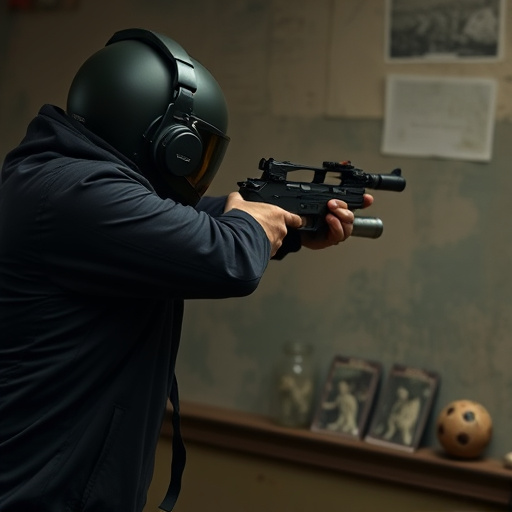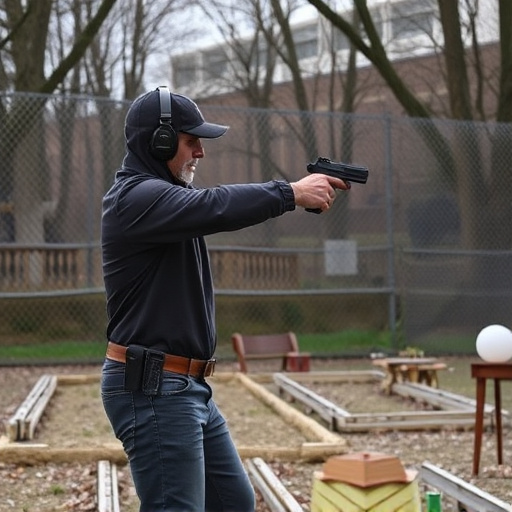Stun Gun Electrode Spacing: Unlocking Best-Rated Self-Defense Tools’ Potential
Understanding electrode spacing is crucial for choosing best-rated stun guns for self-defense. Manuf…….
Understanding electrode spacing is crucial for choosing best-rated stun guns for self-defense. Manufacturers design strategic electrode placement to balance intensity and safety, targeting areas responsible for balance and motor function. The ideal spacing (0.5-1 inch gaps) ensures swift neutralization through clothing penetration while wider models with dual or multiple electrodes enhance current distribution for increased effectiveness.
Discover the secret behind the power of stun guns—it lies in their electrode spacing. This intricate design plays a pivotal role in the device’s effectiveness, ensuring precise and potent shocks. In this comprehensive guide, we explore how understanding electrode spacing can empower individuals to choose the best-rated stun guns for self-defense. By examining various factors and real-world applications, we’ll unlock the knowledge needed to make informed decisions, enhancing personal safety with these innovative tools.
- Understanding Stun Gun Electrode Spacing: Key to Effectiveness
- Factors Influencing the Optimal Spacing for Stun Guns
- Top-Rated Stun Guns and Their Electrode Configuration Analysis
Understanding Stun Gun Electrode Spacing: Key to Effectiveness

Understanding Stun Gun Electrode Spacing: Key to Effectiveness
When it comes to the effectiveness of a stun gun, electrode spacing plays a pivotal role. The best-rated stun guns for self-defense often prioritize strategic electrode placement to ensure optimal shock distribution and maximum impact on the target. Electrodes are designed to disrupt nerve signals and muscle control when activated, rendering an attacker incapacitated. Proper spacing ensures that the electric current flows efficiently through the body, reaching vital areas responsible for balance, coordination, and motor function.
Each stun gun model may have unique electrode configurations, but generally, the spacing is calculated to deliver a powerful yet safe shock. Narrower spacing can increase the intensity of the shock within a smaller area, while wider spacing allows for broader coverage. Manufacturers carefully balance these factors to ensure both effectiveness in neutralizing an assailant and safety for the user, making it crucial to understand the electrode spacing features before investing in a stun gun for self-defense purposes.
Factors Influencing the Optimal Spacing for Stun Guns

The optimal electrode spacing for a stun gun is influenced by several factors, crucial for maximizing its effectiveness as best-rated stun guns for self-defense. Firstly, the size and build of the target play a significant role; larger individuals may require wider electrode separation to ensure a strong enough electrical current flow through the body. Secondly, the type of stun gun matters; different models have varying electrode arrangements, impacting their delivery system and power output. Some stun guns feature longer electrodes, designed for greater penetration, while others prioritize compactness and shorter, more focused electrodes.
Environmental conditions also matter. Wet or moist environments can reduce the stun gun’s effectiveness due to electrical resistance from water. Therefore, proper electrode spacing needs to account for these variables to ensure optimal performance. Additionally, the angle at which the stun gun is applied affects its impact; a direct strike aims to maximize electrode contact area on the target’s body, enhancing current flow and immobilization.
Top-Rated Stun Guns and Their Electrode Configuration Analysis

When it comes to top-rated stun guns for self-defense, understanding electrode spacing and configuration is key to assessing their effectiveness. Modern stun guns employ intricate electrode designs that deliver powerful electric currents to neutralize attackers. The best models prioritize strategic electrode placement, ensuring a wide area of coverage for maximum impact.
Analysis reveals that stun guns with smaller electrode gaps between 0.5 to 1 inch excel in penetrating clothing and reaching the skin, which is crucial for efficient shock transmission. This precise configuration allows users to disable assailants swiftly, even when armed with protective gear. Moreover, some top-tier models feature dual or multiple electrodes, enhancing current distribution and potentially increasing the stun gun’s overall effectiveness.
When it comes to selecting the best-rated stun guns for self-defense, understanding electrode spacing is crucial. This article has explored how optimal electrode configuration enhances the effectiveness of stun guns, with factors like body type and attack range influencing this critical aspect. By analyzing top-rated models and their unique electrode setups, we’ve highlighted key insights to help users make informed decisions, ensuring maximum safety and impact when facing dangerous situations.


